
Published in the September 2009 issue of “Die Porsche Kassette”
First let’s start with the basics.
What is a brake?
By definition, a brake is a device for slowing or stopping the motion of a machine or a vehicle, or alternatively a device to restrain it from starting again.
Following the fact that energy is never lost or created, only transformed, the energy that the car while in motion, called kinetic energy is transformed into heat by the friction created between the rotor and the brake pads. The kinetic energy lost by the moving part is usually translated to heat by friction.
This energy increases exponentially with the speed of the vehicle, so if you double the vehicle’s speed, the energy quadruples, if you triple it, the energy gets multiplied by 9 and so forth.
You can see how the graph looks.

The kinetic energy increases with the mass of the vehicle (m) and with the square of the velocity (E = m • v2). This means that as the speed (v) of the vehicle doubles, it has 4 times more energy and the brakes must therefore dissipate four times as much energy to stop, therefore using 4 times more distance.
This is perfectly illustrated in this Bob Chapman photo of Flying Lizard’s No. 45 at the 12 Hours of Sebring a from couple of years ago.
Notice how the front rotors start to glow red at the end of the long straights.
The racecar’s kinetic energy being transformed into thermal energy (heat) that can actually be seen.
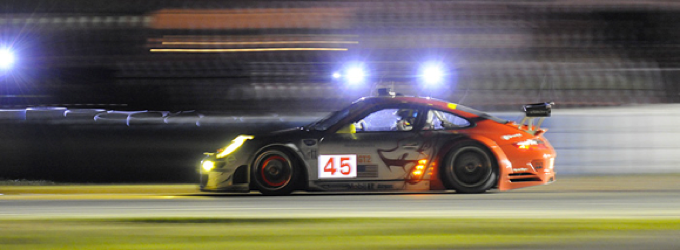
Porsche Brakes are legendary!
To put it into context: The Special Edition Boxster RS 60 with 303 HP can accelerate from 0-60 mph in 5.0 seconds (that’s quite a feat) ... yet it can decelerate from 60-0 mph in 3.4 seconds! (that’s a greater feat).
Braking Power in a Porsche is several times greater than the power output of it’s flat 6 engine.
Our cars now come with standard four-piston-monobock-aluminum-fixed-calipers front and rear and cross-drilled and vented discs (also called rotors).
As far as brakes go, it doesn’t get much better than that, unless ... you dish out another $9,000 and get the same brakes that the Carrera GT came with: PCCB (Porsche Ceramic Composite Brakes).
Porsche Brakes Misconception
All Porsches come with Brembo Brakes.
You can’t imagine how many times people, even Porsche owners, who look at my wheels have said:
“You’ve upgraded your brakes!... You installed Brembos”.
That couldn’t be further from the truth.
ALL modern Porsches come with factory Brembo brakes.
If you don’t believe me, go look at your calipers.
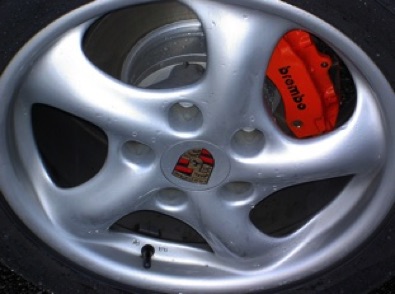
Let’s get a little deeper into the brakes now.
This illustration isolates the Braking System in our cars, showing all the braking components involved.
You can see that at each corner you have a set of calipers with pads hovering over the disc and they are all
connected through a system of mostly hard and some flexible lines to a pump that gets actuated by the brake pedal.
1- Backing plate
2- Rotor (cross-drilled)
3- Caliper (4 piston)
4- Retainer and pin
5- Spring
6- Dust seals
7- Sensors
8- Pads
9- Lower Caliper tube
10- Caliper bolt
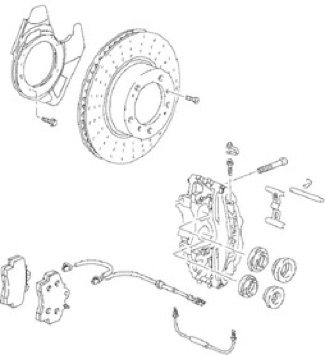
The ABS, or Anti-Locking Brake System) which all of our cars also have is a secondary system which operates in tandem with the Brake System.
It’s basically a safety feature in modern cars that doesn’t allow any one of the tires to lock up under heavy or panic braking.
There’s the:
1- ABS Control Unitwhich monitors each wheel’s
speed compared to the other three.
2- Brake Unit which is made up of the Brake Booster
and Master Cylinder
3- ABS Hydraulic Unit
4- ABS Speed Sensors, one in each corner which sample
each wheel’s individual speed and sends the information
to the Central Information System
5- Central Information System
7- Brake Lights6- Brake Proportioning Valve
8- Brake Light Switch
9- ABS Warning Light- ABS control unit
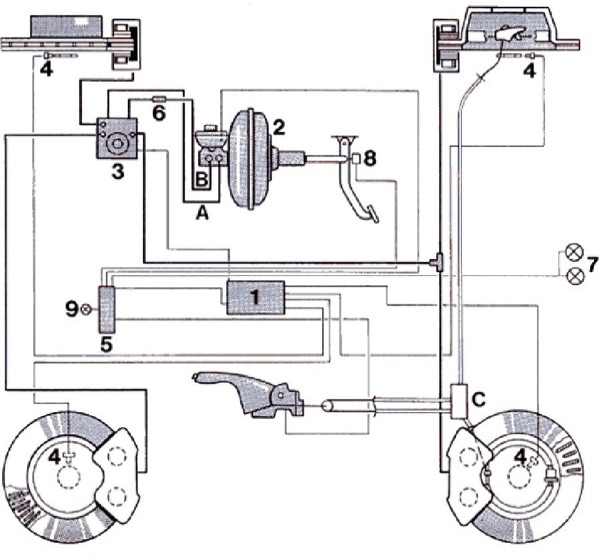
As we explained before, a great amount of heat is generated when stopping the car.
Because of that the rotors are internally ventilated, forcing cool air through the inside of the rotors as they rotate. The cars also have cooling ducts to direct oncoming air directly to the front brakes, which generate the most heat because they do the most work.
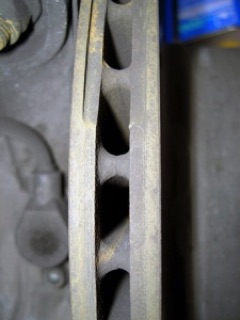
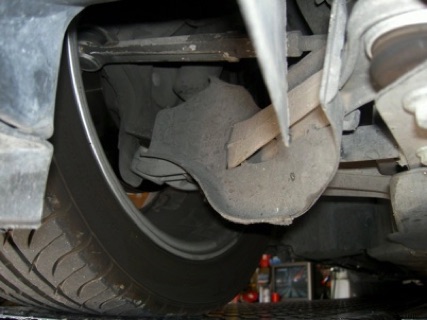
And why, you may ask yourself, do the fronts wear out faster than the rears?
The answer is because of the ever present weight transfer phenomenon.
Let’s assume we have a 2800 lb Boxster with a 50/50 weight distribution.
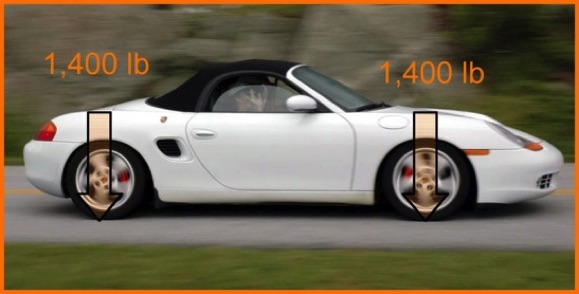
Note that when the vehicle is coasting, or at rest, there are no horizontal left or right arrows acting on the car.
All forces are acting in a vertical direction.
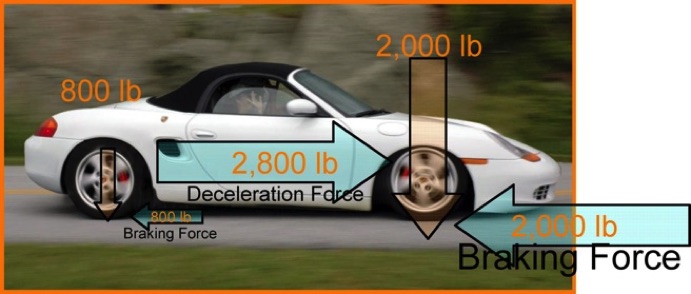
But what happens to a vehicle when we start applying the brakes?
During braking weight is transferred from the rear axle to the front axle.
You can certainly feel this effect as your body and everything loose in the car goes forward.
This is also called deceleration and can be represented in the formula F = ma
Where “F” represents the forces acting at the contact patches, “m”
represents the mass of the vehicle, and “a” represents the acceleration
(or deceleration) of the car.
At this point a braking system designed for a perfect 50/50 weight distribution would apply too much braking to the rear axle, causing the rears to lock before getting as much work as possible out of them, therefore the manufacturer has to induce brake bias, meaning that the front brake pads clamp down on the rotors with more force than the rears.
F=ma
Most of the new brake rotors are now cross-drilled from the factory.
The purpose for cross-drilling is to allow for the quick escape of gasses between the pads’ and the rotors’ surfaces. These gasses are generated by the application of the brakes when the great heat generated tend to sublimate some of the pad. A second advantage to cross-drilling the rotors is that there is much less brake fade when wet. One of the disadvantages is that is the cross-drilled rotors tend to crack around the perforations, so chamfering helps to relieve the cracks. Also chamfering eliminates a bit of the cheese grater effect on the pads.
Some people prefer slotted rotors which allow for gas and water to escape, but don’t crack as the cross-drilled.
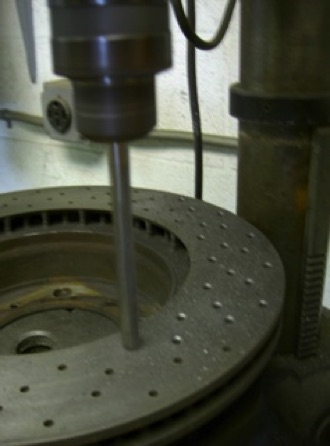
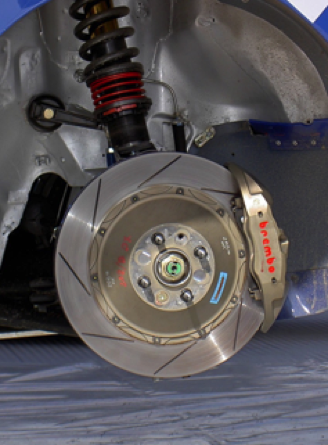
Brake maintenance is really one of the simplest jobs you can do on your car.
Happy Porsche’ing,

© 2009 Technolab/PedrosGarage.com

